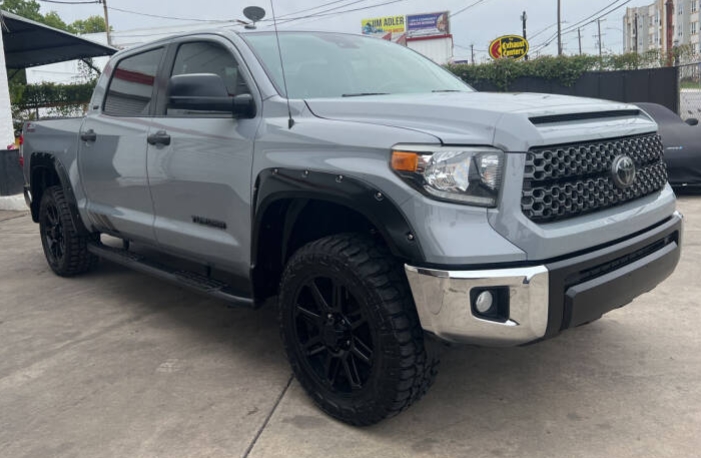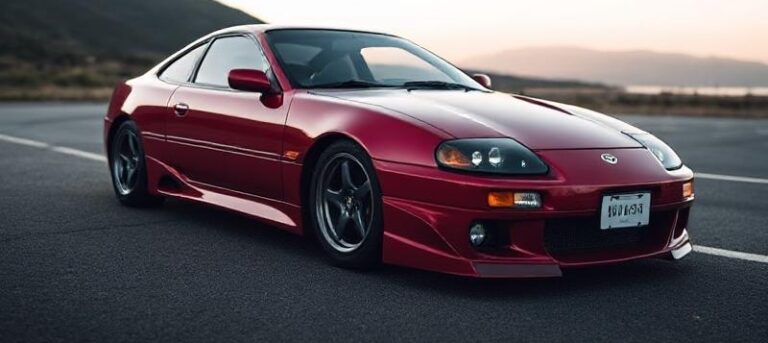The Unyielding Evolution of the Toyota Tundra: A Chronicle of Grit and Growth
For decades, the pickup truck segment has been a fiercely contested battleground, dominated by American manufacturers whose heritage is deeply interwoven with the very fabric of these workhorses. Yet, against this formidable tide, a Japanese challenger emerged, not with brute force, but with an unwavering commitment to reliability, innovation, and a surprising capacity for toughness. This is the story of the Toyota Tundra, a truck that has steadily, and sometimes surprisingly, evolved from a humble newcomer into a respected contender, embodying Toyota’s signature blend of engineering prowess and enduring quality.
The Tundra’s journey began in the late 1990s, a period when Toyota was meticulously analyzing the North American market and identifying a significant gap in its product portfolio. While the Tacoma had carved out a strong niche in the mid-size segment, a full-size truck was deemed essential to capture a larger share of the lucrative pickup market. The result of this strategic foresight was the first-generation Tundra, which rolled off the assembly line in 1999 (for the 2000 model year) as the Toyota T100’s successor.
First Generation (2000-2006): The Foundation of Resilience
The initial Tundra was a carefully considered attempt to break into the full-size market without alienating Toyota’s loyal customer base. It was built in a new, dedicated plant in Princeton, Indiana, signaling Toyota’s serious commitment to this segment. Early Tundras were available in a single body style: a regular cab and an access cab (which featured small rear doors for occasional passengers). The Double Cab variant, offering four full doors and a more spacious rear cabin, arrived later in the 2004 model year, significantly enhancing its family-friendly appeal.
Under the hood, the first-generation Tundra initially offered a 3.4-liter V6 engine, producing around 190 horsepower. This was a conservative choice, reflecting Toyota’s focus on fuel efficiency and reliability over outright power. However, realizing that American truck buyers often craved more grunt, Toyota introduced a potent 4.7-liter i-Force V8 engine in 2000. This V8, with its 240 horsepower, became the defining powertrain for the Tundra and a key selling point, offering a significant step up in performance without sacrificing Toyota’s reputation for durability.
Trim levels for the first generation were relatively straightforward, evolving over its six-year run. Early models typically featured:
- DLX: The base model, offering essential features for hardworking individuals.
- SR5: A step up, adding more comfort and convenience features.
- Limited: The top-tier offering, providing premium amenities and a more refined experience.
A significant mid-cycle refresh occurred for the 2005 model year. This update brought a bolder grille and front-end styling, along with a series of mechanical enhancements. The most impactful change was the introduction of a new, more powerful 4.7-liter i-Force V8 engine with Variable Valve Timing with intelligence (VVT-i), boosting horsepower to 270. A 5.7-liter V8 was not yet available in this generation. The Double Cab body style also gained more prominence during this refresh.
The first-generation Tundra established Toyota’s presence in the full-size truck market. While it didn’t immediately dethrone the established giants, it garnered a loyal following for its exceptional reliability, comfortable ride, and surprisingly capable V8 performance. It proved that a Japanese truck could indeed compete, even if it was playing a slightly more conservative game.
.
NO MORE dead batteries with this:

.
Second Generation (2007-2021): The i-Force Revolution and Expanded Capabilities
The year 2007 marked a seismic shift for the Toyota Tundra. The second generation was a complete redesign, a bold statement of intent from Toyota, and a significant departure from its predecessor. This new Tundra was larger, more powerful, and designed with a much more aggressive stance, clearly aiming to compete head-on with the heavyweights of the segment.
The most significant innovation of the second generation was the introduction of the legendary 5.7-liter i-Force V8 engine. This powerhouse delivered a stout 381 horsepower and 401 lb-ft of torque, finally giving the Tundra the muscle to compete with the most potent offerings from Ford, Chevrolet, and Dodge. Alongside this behemoth, the reliable 4.6-liter V8 (replacing the older 4.7L) and a 4.0-liter V6 were also offered, catering to a wider range of needs and budgets.
This generation embraced a modular design, offering a wider array of configurations. The three primary body styles were:
- Regular Cab: The no-frills workhorse.
- Double Cab: Four full doors and a spacious cabin, maintaining comfort for passengers.
- CrewMax: A larger cabin and shorter bed, prioritizing passenger space and offering a truly executive truck experience.
The second-generation Tundra also introduced a more diverse range of trim levels, reflecting the evolving demands of truck buyers:
- SR: The entry-level workhorse, offering essential features and durability.
- SR5: A popular mid-range option, adding more comfort and convenience features.
- TRD Sport: Introduced in 2018, this package focused on improved handling and a sportier aesthetic, featuring Bilstein shocks and unique styling cues.
- TRD Pro: Launched in 2015, this off-road focused trim became a significant draw, equipping the Tundra with enhanced suspension (including FOX shocks), skid plates, and aggressive all-terrain tires, making it a formidable adventure vehicle.
- Limited: Offering a blend of comfort and capability, with premium interior appointments and advanced features.
- Platinum: Positioned as a near-luxury trim, emphasizing refined materials, advanced technology, and a quiet, comfortable ride.
- 1794 Edition: Introduced in 2014, this trim celebrated the founding year of the Tundra’s assembly plant in San Antonio, Texas, and featured a Western-themed, premium interior with unique badging and accents.
The second generation saw several notable updates throughout its extensive lifespan. A significant facelift occurred in 2014, bringing a bolder, more imposing grille, updated interior materials, and the introduction of the popular TRD Pro and 1794 Edition trims. The 2020 model year saw some powertrain adjustments, with the 4.0L V6 being discontinued, leaving the 4.6L and 5.7L V8s as the sole options. Apple CarPlay and Android Auto integration arrived for the 2021 model year, bringing modern smartphone connectivity to an aging platform.
Despite its long run, the second-generation Tundra was lauded for its robust construction, excellent V8 engines (especially the 5.7L), and Toyota’s unwavering reliability. While some competitors introduced more advanced powertrains like turbochargers and hybrid systems, the Tundra remained a solid, dependable choice, particularly appealing to those who valued simplicity and longevity.
Third Generation (2022-Present): The Hybrid Era and a Bold New Direction
After a remarkable 15-year run, the third-generation Tundra arrived for the 2022 model year, representing a complete and transformative overhaul. This new Tundra embraced modern automotive technology and design, shedding its previous V8 exclusivity in favor of a more efficient and potent hybrid powertrain, a testament to Toyota’s commitment to electrification and performance.
The heart of the new Tundra is the i-Force MAX hybrid powertrain. This system pairs a twin-turbocharged 3.5-liter V6 engine with an electric motor and battery pack, delivering a remarkable 437 horsepower and 583 lb-ft of torque. This powerplant not only offers exhilarating acceleration but also significantly improves fuel efficiency compared to the outgoing V8s. For those seeking a non-hybrid option, a twin-turbocharged 3.5-liter V6 engine (i-Force) is also available, producing 348 horsepower and 405 lb-ft of torque. Both powertrains are mated to a new 10-speed automatic transmission, offering smoother shifts and enhanced control.
The third-generation Tundra features three distinct body styles:
- Double Cab: Available with a standard or long bed.
- CrewMax: Available with a standard or short bed, offering the most passenger space.
Toyota has continued its tradition of offering a wide array of trim levels, catering to diverse customer needs:
- SR: The entry-level model, still emphasizing value and practicality.
- SR5: A popular mid-range choice with more features and available options.
- Limited: Offering a more refined interior and advanced technology.
- Platinum: Elevating the luxury and comfort, featuring premium materials and cutting-edge amenities.
- TRD Pro: Continuing its legacy as the ultimate off-road variant, with enhanced suspension, all-terrain tires, and exclusive styling.
- Capstone: Introduced for 2023, this ultra-premium trim sits at the top of the lineup, featuring a decadent interior with semi-aniline leather, acoustic glass for a quieter cabin, and a host of exclusive appointments, rivaling luxury SUVs.
The third generation has been praised for its significantly improved on-road manners, advanced technology, and the impressive power and efficiency of the i-Force MAX hybrid system. Toyota has also integrated a wealth of driver-assistance features as standard, enhancing safety and convenience.
The Enduring Legacy of the Tundra
From its humble beginnings as a V6-powered newcomer to its current status as a potent hybrid powerhouse, the Toyota Tundra has undergone a remarkable evolution. It has consistently proven its mettle against formidable competition, not by chasing fleeting trends, but by adhering to the core principles that define Toyota: unwavering reliability, meticulous engineering, and a commitment to continuous improvement.
The Tundra’s journey is a testament to its adaptability and its growing understanding of the North American truck buyer. It has evolved from a truck that was “good for a Toyota” to a truck that stands shoulder-to-shoulder with the best, offering a compelling blend of performance, capability, and the enduring peace of mind that comes with the Toyota badge. As the automotive landscape continues to shift, the Tundra’s continued evolution, particularly with its embrace of hybrid technology, suggests that this unyielding spirit of grit and growth will ensure its place in the pickup truck pantheon for years to come.







